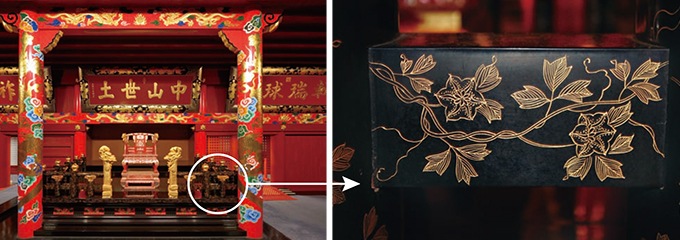MENU
Flowers Drawn in the Seiden The Story of the Clematis
Home > About Shurijo Castle > Ugushiku Monogatari (Story of Shurijo Castle) > Flowers Drawn in the Seiden The Story of the Clematis
According to historical records, the second floor of the Seiden is referred to as Ufugui. In the center of the Ufugui is a raised section called Shumidan, which is higher than the floor and where the king’s throne sits. Around the Shumidan are black handrails called Koran on which flowers are depicted.
Drawn on the black lacquer background color are gold line engravings of “clematis flowers” that stand out conspicuously. This gold line engraving is one of the traditional techniques of lacquerware production known as chinkin, and the clematis flowers are drawn using this lacquerware technique.
Along with roses and wisteria flowers, the clematis is known as a flower that is often used in English gardens, but in East Asia, it is actually a flower referred to as “tessen” in historical documents. Although this tessen is originally a flower native to China, it came to be called clematis when it was introduced to the West from China. When it was brought into mainland Japan and the Ryukyus from the Korean Peninsula, it was introduced with the same Chinese notation of tessen.
Although it may be hard to believe that a flower that appears in English gardens is drawn on the throne area of the king of the Ryukyu Kingdom, the floral patterns of the tessen, which is native to China, became extremely popular during the Edo era as designs on craftwork and clothes such as women’s kosode (short-sleeved kimono). It is believed that the tessen floral patterns consequently came to be incorporated as designs in craftwork and clothes in the Ryukyus.
Similar to the grapes and squirrels depicted in the siding panels of the lower section of the king’s throne area in the second floor of the Seiden mentioned previously, the Ryukyuan people could have not seen the real flowers, but it is believed that Ryukyuan artists, who were sensitive to fashion in mainland Japan, obtained tessen designs and drew them on the throne area in the Seiden. In modern parlance, it may be said that they took the “latest mode” trending in Edo or Kamigata (Kansai region) and used it for the pattern in the throne area.
Perhaps the Ryukyuan people at the time understood that the grapes and squirrels drawn in the lower section of the king’s throne area were patterns originating from China, while, despite its being a plant that was originally native to China, the clematis drawn on the Koran railing in the throne area of the king were Japanese designs because they were introduced into the Ryukyus after they became popular in mainland Japan. Therefore, it can be thought that the Chinese patterns and the Japanese patterns were used in a well-balanced manner in the king’s throne area. Perhaps it was a sense of consideration unique to a kingdom in the Nansei Islands (Ryukyu Arc), which lie between Japan and China. Nothing can be said of the secret behind the combination of the designs in the king’s throne area now, as the truth lies beyond the Ryukyu Kingdom era – a very distant past. However, it may be interesting to visit the Shurijo Castle Seiden while imagining the thoughts of the Ryukyuan people at the time.
Please by all means try to take a look at the flowers painted in the king’s throne area in the Shurijo Castle Seiden.
(Yasuyuki Uezu)

Clematis drawn on the Usasuka on the second floor of the Seiden and on the Koran railing in the Usasuka
© Shurijo Castle Park All Rights Reserved.